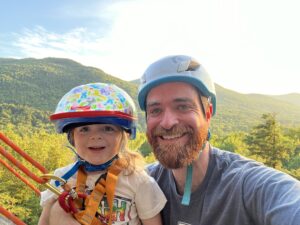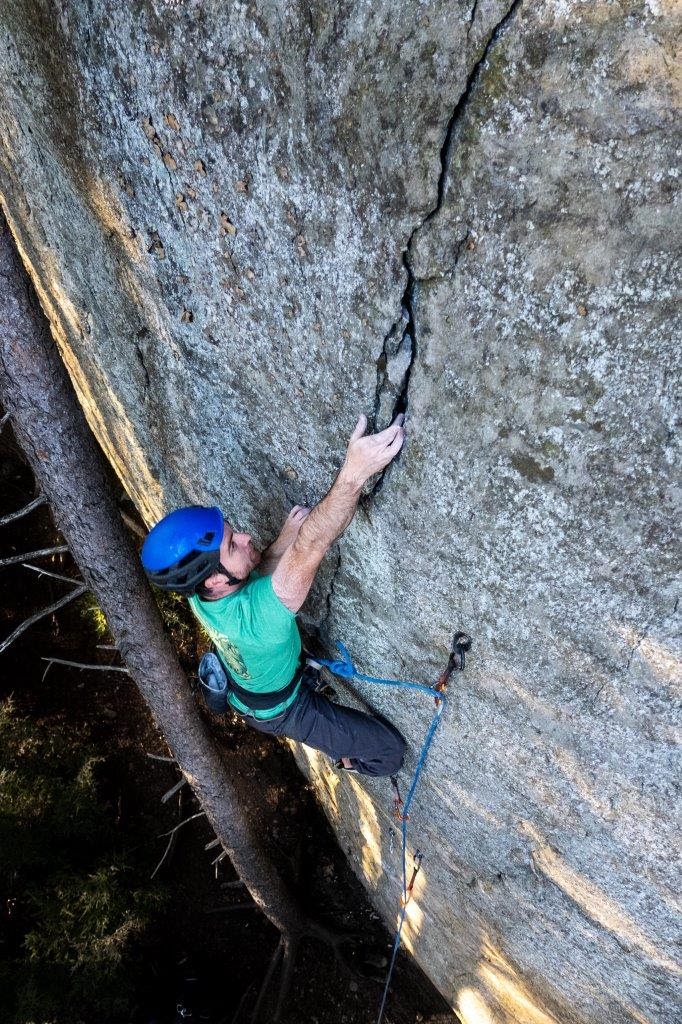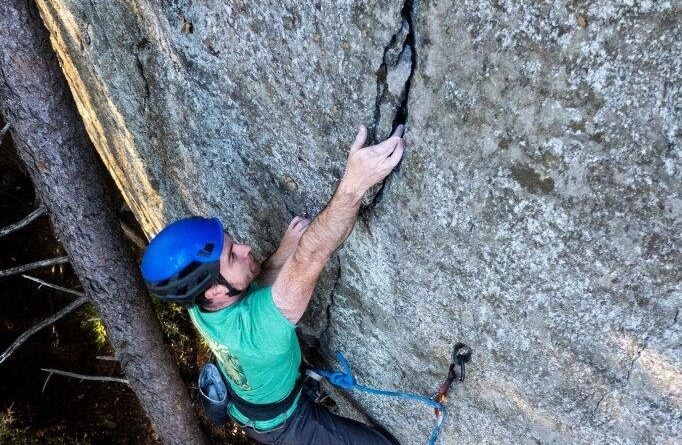Mischa Tourin: The Climbing Advocate
Name: Mischa Tourin Age: 38
Family: Wife, Claire, daughter Hazel 3, and son Rowan 1
Lives in: Underhill
Primary Sports: Rock climbing and ice climbing
Occupation: Rock and ice climbing guide and outdoor educator
Native Vermonter Mischa Tourin has travelled the world, but after satisfying his wanderlust, he returned home to become an invaluable part of the climbing
community and a member of the board of CRAG Vermont, the state’s climbing association. Climbing helped Tourin overcome his fear of heights, and as a rock-climbing guide and outdoor educator, he helps others conquer their fears too.
How long have you been rock climbing?
I’ve been climbing for 25 years. Before Petra Cliffs opened, I climbed at the Burlington Rock Gym which was actually in Essex. My dad was a rock climber and when I was 13 or 14, he decided that my brother and I should know that there was more to climbing than indoor walls, so he hired a guide and took us out on Cathedral Ledge in New Hampshire. It was a multi-pitch climb. I was really scared but I was hooked.
Did ice climbing come after that?
That came later, maybe ten years ago, when I was living in Colorado. I was working in wilderness therapy, and I’d have eight days on and six days off. My friends and I would go exploring in our off time and we ended up ice climbing in Ouray.
When did you join CRAG Vermont?
When I moved back to Vermont from Colorado, I really wanted to connect with the local climbing community and see how I could pitch in. I had heard about the opening of Bolton Dome and wanted to be part of that, so I started going to CRAG Vermont meetings. It was a much smaller organization at that point and if you showed up at enough meetings, they’d convince you to join the board. That happened in 2017. I started seeing all the things I could do like help with the website and the climbing festival. People saw that I had energy, so I became vice president in 2019.
How does Vermont compare to other places you have climbed?
With the Adirondacks on one side and Whites on the other, Vermont has this humble reputation as being a little bit of a backwater, local crag. There is some truth that our cliffs are smaller than our neighbors’, but there has been a lot of good development and a really good community here. People are now realizing that Vermont has a lot of really great climbing. A lot of our routes are schist which used to characterize what people thought of Vermont climbing. But in 2019 CRAG Vermont worked to open Lone Rock Point in Burlington which has overhung, really hard limestone. CRAG just recently signed a memorandum of understanding with the state to be a recreation corridor manager for Black Mountain in the Northeast Kingdom which has perfect granite cracks.
We’ve started opening up a lot more climbing around the state, which has diversified our offerings.
Given your description of rock, how important is it for a climber to have knowledge of geology?
You don’t need it, but it helps because the way you read different rocks can lead to different climbing styles. Some places have perfect splitter cracks, like the granite of Yosemite or the Wingate sandstone in parts of Utah, making parallel fissures that are perfect for hand jamming. Schist tends to be lower angle with little quartz crimps which only have room for your toes or fingertips,.Limestone usually has steep walls with big overhung pockets.
I’ve read that you’re afraid of heights. Is that true?
I was. That’s why I started climbing; to overcome that. I pass along to the kids I work with that the way to grow is to expand your comfort zone and scare yourself a little. There is a lot of growth when you have fear and anxiety. I’m still afraid of heights when I step outside of where I’m comfortable, but I’ve expanded that zone quite a lot and I’ve climbed 2,000-foot rock faces.
Do you have a favorite place to climb?
Definitely Black Mountain in Averill. It’s as far as you can get from civilization in Vermont and it’s right next to the Silvio Conte Wildlife Refuge and the Atlas timber lands where the state has an easement. CRAG spent many years going through the process to be the climbing recreation manager there which means we can officially represent climbers and do what is needed for access. The mountain has amazing granite cracks.
cCan you tell us about your most memorable climb? I do some route development and my favorites climbs are the ones that people do a lot, not necessarily the hardest ones. I developed a 5.3 route at Bolton Dome. It’s probably the easiest route in Vermont, but I cleaned it off and climbed it with my dad who was 77 at the time and hadn’t climbed in a few decades. I also did it with my wife when she was 20 weeks pregnant. We didn’t have a name for the baby yet, so we called it Little Wolf and named the route that. Now that our daughter is “Hazel,” she’s climbed it on her own.
I do some route development and my favorites climbs are the ones that people do a lot, not necessarily the hardest ones. I developed a 5.3 route at Bolton Dome. It’s probably the easiest route in Vermont, but I cleaned it off and climbed it with my dad who was 77 at the time and hadn’t climbed in a few decades. I also did it with my wife when she was 20 weeks pregnant. We didn’t have a name for the baby yet, so we called it Little Wolf and named the route that. Now that our daughter is “Hazel,” she’s climbed it on her own.
Tell us about your business, Sterling Mountain Guides.
I’d been working in education for about a decade, first in wilderness therapy and then at a therapeutic alternative high school in Colchester. I’m still at that high school and I love working with those students. Three summers ago, I started guiding rock climbing in the summer and really loved it, so I opened my own guide service in 2021. It started as just a summer thing but now I work two days a week at the school which gives me more time during the school year for guiding.
What is involved in being a certified AMGA Single Pitch instructor?
You have to take a three-day course and then pass a two-day exam. I did that eight years ago and every few years you have to get recertified. This year, I took the Rock Guide Course which is ten days so now I’m certified as an Apprentice Rock Guide and can guide up to Grade II multi-pitch climbs.
What led you to become a wilderness first responder and NOLS educator?
I took the NOLS class early on and that’s what inspired me to see guiding and outdoor education as a career path. I’d done a lot of work with youth and wanted to do more of that outside. I took the wilderness first responder class after that because for pretty much everything I do – backpacking with teenagers or guiding – you really need to be able to respond to medical emergencies. It’s one certification that everyone who works outdoors should have.
 Tell us about this September’s Vermont Climbing Festival.
Tell us about this September’s Vermont Climbing Festival.
This is the fifth year of the festival although in 2020 it was virtual because of Covid. We’ll be at Cochran’s again September 22-24 and we’ll have a ton of clinics at reasonable rates. I’m really excited that we’ll have Maureen Beck, an adaptive climber who has just one hand, as our keynote speaker. She was a board member before she went out west and became famous as a Paralympian and sponsored by North Face. She has a hilarious social media account and we’ve been hoping to get her back here as a speaker for years.
Will there be competitions at the Festival, too?
We’ll have all kinds of events including the Donny Wall Dyno competition. A dyno is a dynamic movement which requires you to jump to reach the next hold. Usually, you fully disconnect and use upward momentum to make the leap. Competitors have a minute to complete as many as possible and get more points for the harder ones.
We’ll also have a competition featuring my invention – the Crack Wrestling Machine – which is a little bit like arm wrestling, except you’re using a jam and you can use all kinds of holds including finger stacks, ring locks, hand jams, fists, and butterfly stacks. There will be a DJ playing in the background and it’s a whole lot of fun to watch. This year we’ll also be having a Moth story hour hosted by one of our local legends, Bill Patton.
What else happens?
There are clinics for everyone from beginners up to advanced climbers who want to learn to self-rescue. There will also be yoga, and talks on establishing new routes, trail building, geology, and peregrine falcons. We usually have around 300 people. There are a lot of locals but there are also climbers coming from all over the Northeast and even further. It’s a mix of all sorts. We’ve got everyone from high school students to senior citizens. We’ve done some work to make the festival more accessible and with Mo speaking, we’ll also have a para-climbing clinic. We would like to make the cliffs more accessible to people who are not able-bodied. Sometimes, the hardest part of climbing is the trail on the way in.
How challenging has the weather been for climbing this past summer?
It’s been a really challenging season. This winter wasn’t good for ice climbing either and this wet, wet summer has been hard. Rock is not enjoyable when it’s wet. Even if it rained the day before, the rock may still be wet. What really kills ice climbing are those warm thaws which reset everything and between the less icy winters and this wet summer, it’s been hard. Climate change has not been great for us
What’s next for CRAG VT?
We’ve really been working to expand where our focus is. We’ve been in a cycle where most of our climbers have been from Chittenden County and northwest Vermont, so a lot of our work has been there and some of the climbers in southern Vermont have felt left out. We’ve been connecting with them to figure out where they have access issues and where we can help. There are some interesting projects for access to climbing in southern Vermont. We also feel as though we’ve underrepresented bouldering. Richmond Mountain Trails opened a large adaptive bike trail called the Driving Range in Bolton and CRAG pitched in $5,000 for the development of a multi-use, 55-car parking lot that will open access up to the Pinneo Brook bouldering area. Last year, we got our first grant-funded trail building project for stairs at the Bolton Dome. We want to harden the trail and make the area more sustainable, less susceptible to erosion, and easier to access. We’re continuing to build community and to look for new places where access issues need to be solved. At some point we’ll run out of cliffs to open to the public. There are more that we are interested in, but these days, we are really focusing on building community.
—Phyl Newbeck

